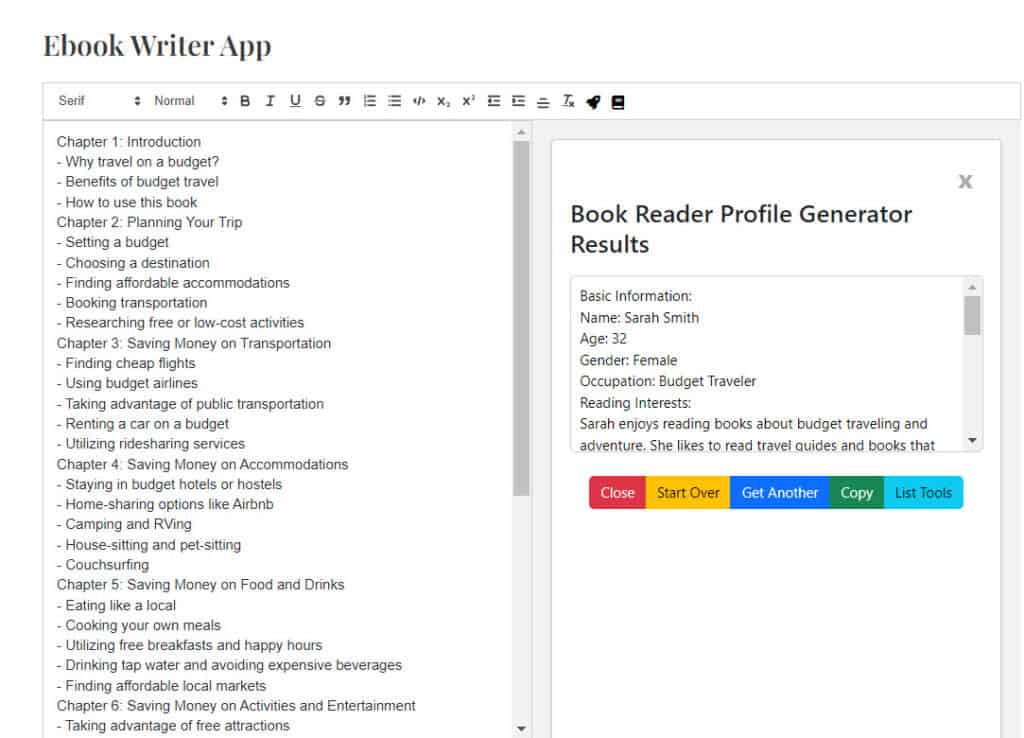This blog post will help guide you on How to write Ebooks using AI by using the ai writing software on prowritingtools.com to help you make your ebook idea into a sellable product.
Artificial intelligence tools are all the rage, and people use tools like CHATGPT or Jasper ai to crank out ebooks. While these tools can be very useful, how you use them can make a difference. While you might get some sales by simply cranking out lots of content, you’ll get more sales if you take some extra time to focus on quality. People don’t want to read nonsense; they want to solve their problems. They want to be entertained.
We’ve made some ai writing tools to help you write content in as little time as possible without sacrificing quality.
You can find all the tools mentioned on this page in the member dashboard or in the Ai Ebook Writer this website. You must be signed in to access this with either a free or paid account.

Suggested Writing Software
- A free or paid account on prowritingtools.com
- Software to organize your work, such as Scrivener, Calibre, or Google Docs
- Software to convert your documents into a publishable format. This is built into Scrivener.

How to write Ebooks using AI – Step by Step
Choose Your Topic
A well-used piece of advice is to write what you are passionate about. While this does have some value, you need to balance it with subjects that potential readers are interested in. For example, if you are extremely interested in underwater yak shearing but are alone in that subject, you’ll only be writing for your own pleasure. This brings us to the subject of niches.
Related Tool – Book Idea Generator
What is a niche?
A niche is a specialized area of focus within a larger market that caters to a particular audience. A niche can be any topic, product, service, or industry, and it typically has less competition than the broader market.
You find a niche by picking a broad topic and then narrowing it down until you find something more specific.
Examples of ebook niches
- Gluten-Free Cooking
- Self Improvement
- Natural Remedies
- Homemade Soap Making
- Home Decorating Ideas
- Digital Photography Techniques
- Pet Care & Training
- Essential Oil Recipes
- Aquaponics for Beginners
- Travel Writing and Blogging
We can narrow it down even further by picking a sub-niche. This is done by picking a niche and narrowing it down to a specific audience. Say, for example, you wanted to write about the subject of Pet Care & Training. We can narrow it down to a very detailed subject.
Examples of sub-niches
- Pet Grooming
- Dog Training
- Cat Training
- Aquatic Pet Care
- Exotic Pet Care
- Canine Obedience Training
- Veterinary Services & Care
- Animal Behavior Analysis & Modification
- Reptile Care & Handling
If you need more specific inspiration, you can see an extensive list of subniches we’ve put together, or you can use our niche & subniche finder tool.
The advantage of using sub-niches is reaching a more specific, targeted audience. Using sub-niches, you can tailor your message and product offering to appeal more directly to a specific demographic or group.
A pet owner of a lizard would have more interest in a book on reptile care rather than a book on general pet care, where they would have to wade through pages on dogs and cats to find what they were interested in.
Research Your Audience
Gathering information about your target readership is essential for understanding their needs. Knowing who your audience is, what they like and dislike, and what their interests are can help you create content that will be more relevant to them. This can also help you better understand the topics that they would be interested in reading about so that you can craft content specifically tailored to their interests.
Related Tool: Reader Profile Generator
Outline Your Content
Map out the content of your ebook by brainstorming ideas, organizing them into categories, and creating a timeline for each section. You can use the ebook outline tool to do this; that way, you’ll get a list of headings and sections. Edit these to your preference, discard what you think won’t work, and add your own ideas to the list.
Related Tool – book outline generator
You’ll now have all the chapters, and then all you need to do is fill in those sections’ content.
Write the content
Fill in the paragraphs.
Related Tool: Paragraph Generator
Use the paragraph generator to fill in the outlines section. Edit the paragraphs to make sure the ideas fit together. Make your prompts as detailed as possible to cut down on editing time.
Bad Examples
- Write a paragraph about coding javascript
- Write a paragraph about cooking Italian
- Write a paragraph about cats.
Good Example
- Write a paragraph about coding javascript games for beginners using Phaser.
- Write a paragraph about cooking Italian dishes from southern Italy focusing on garlic and tomatoes.
- Write a paragraph about traveling with cats on long car journeys.
Add Special Content.
Special content sections of information include:
Using special content to break up content can be a great way to make your message more straightforward for readers to digest and understand. Content such as lists helps readers quickly identify the main points you want them to remember and allows for easy skimming of long pieces of text.
We used the list above to help our readers understand what special content can be included. It would not be as readable if we put it in a paragraph.
Proofread and Edit your book.
Proofreading and editing your book is essential to ensure it reads well and accurately conveys your message. It is hard to take a metaphorical pair of scissors to your work, but if anything doesn’t work or seems quite right, you’ll need to cut or rewrite it.
Sometimes proofreading your own work can be problematic because you are so familiar with the work. You may be too close to the material to detect errors or inconsistencies. You might want to consider hiring a professional proofreader and editor to review your work before publication. A good proofreader will check for typos, grammar mistakes, spelling errors, incorrect punctuation, incorrect formatting, and other issues that can detract from the readability of your book.
If you do want to do the proofreading yourself, it can be helpful to read it out loud. Hearing yourself speak it will make you aware of how it will sound in your reader’s mind.
Design the Cover
Unless you are a designer, you have two choices when it comes to making a cover for your ebook. Use a template from somewhere, such as Canva, or hire someone to design it for you.
A professionally designed ebook with its distinctive look and feel will help you stand out from the competition. It allows you to present your content in an attractive and engaging format, allowing readers to access the information they seek quickly.
You can also use an AI image generator to help you design your ebook cover.
Finalize & Publish
Publishing your own ebook online is a great way to get your work out into the world. It provides you with an easy and cost-effective way to share your story and allows readers from all over the globe to access your book.
Format the document with proper fonts, images, links, etc.; read and reread the book. Once everything is ready, upload it to a publishing platform like Amazon Kindle Direct Publishing or Smashwords to make it available to purchase online as an eBook or print book.
You can also publish it as a PDF file and give away the book as a free gift.
Conclusion
In conclusion, writing an ebook with AI can be a powerful tool for serious authors. AI technology can help them create content quickly and accurately while also providing helpful insights into the market trends that they can use to optimize their work and ensure success.
